Exploring the top 07 traditional craft villages in Hue - Handspan Travel Indochina
2Hue, located in the central region of Vietnam, is famous for its ancient beauty and cultural and historical sites. Besides, the traditional craft villages in Hue, which have many artistic and traditional values, are also outstanding features of this destination. Coming here, you can learn about the process of making traditional craft products. Let’s explore the top 07 Hue traditional craft villages with Handspan Travel Indochina!
Through this blog post, you will find detailed information about these craft villages below.
Thuy Xuan Incense Village
Thuy Xuan Incense Village is one of the traditional villages in Hue that you should visit. The village is located on Huyen Tran Cong Chua Street, near Vong Canh Hill, 7 kilometers from the Hue city center to the Southwest. The incense-making traditional craft appeared here from about 700 years ago under the Nguyen Dynasty.
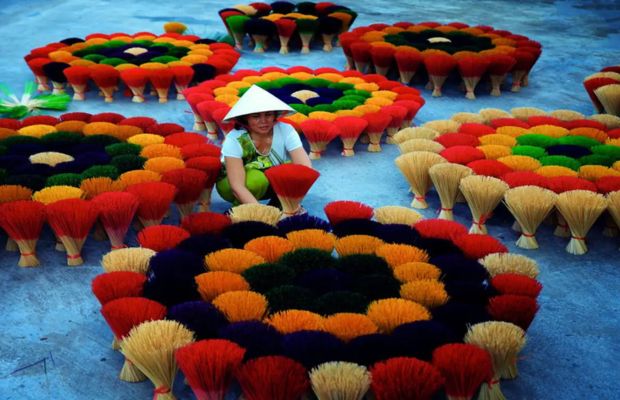
Thuy Xuan Incense Village
In the past, the village was a place to supply incense to the royal court, mandarins, and people in the Thuan Hoa and Phu Xuan regions. Coming here, you will feel amazed with the village’s ancient beauty and colorful bouquets of incense. This craft village is famous for many unique products such as agarwood cones, coiled incense, cinnamon incense, lemongrass oil incense, etc. Among them, agarwood incense is a prominent product that is indispensable in the spiritual life of Vietnamese people. This high-quality product is distributed to local markets and transported to many other provinces across the country.
Visiting Thuy Xuan Incense Village, don’t miss out on the opportunity to enjoy these experiences below.
Taking photos
Thuy Xuan Incense Village is an ideal place to take stunning photos. The colorful incense under the sunlight is a glistening background for your photos.
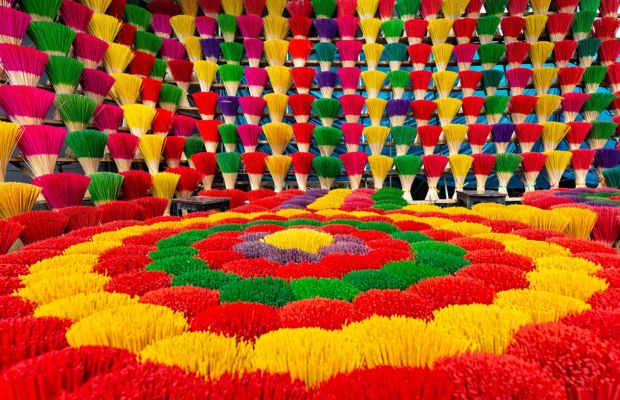
Colorful incense in Thuy Xuan Incense Village
Exploring the process of making incense
The village’s incense products can exist for a long time due to the delicate and meticulous way of making incense. Thuy Xuan incense has a light and elegant scent without chemicals. Each incense stick must go through many elaborate preparation stages to fully preserve the characteristic scent of pure agarwood. Coming to the place, you can learn about this process.

A woman artisan in Thuy Xuan Incense Village
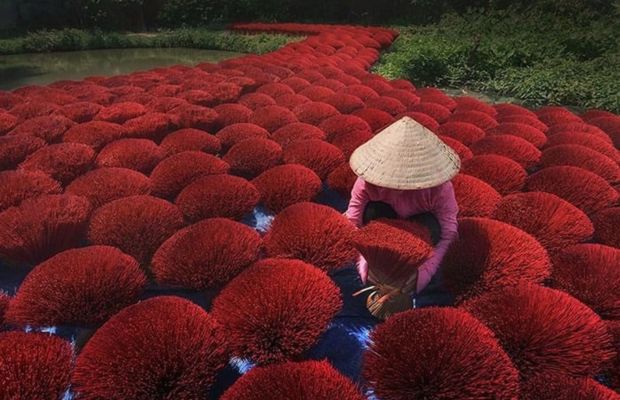
Making incense in Thuy Xuan Incense Village
Making the incense yourself
Learning to make the incense by yourself is an exciting experience in Thuy Xuan Incense Village. This is a chance for you to understand this traditional craft village and the life of local people. The artisans will guide you through each step of making incense and support you to make the most perfect product.
Walking around the village
Besides learning about the incense-making process, you can walk around and drop by the souvenir shops here. You can buy Agarwood incense, cinnamon incense, deodorant incense, lemongrass oil incense, and handicraft products such as fans, oil paintings, brocades, etc., as gifts for relatives and friends after their trip to Hue.
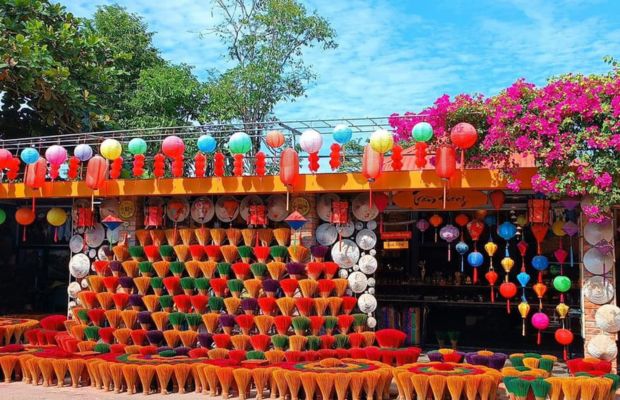
An incense shop in Thuy Xuan Incense Village
Overall, with exciting experiences and charming scenery, Thuy Xuan Incense Village is undoubtedly among the worth-visiting traditional craft villages in Hue.
Phu Cam conical hat village
- Address: South bank of An Cuu River, Phuoc Vinh ward, Hue
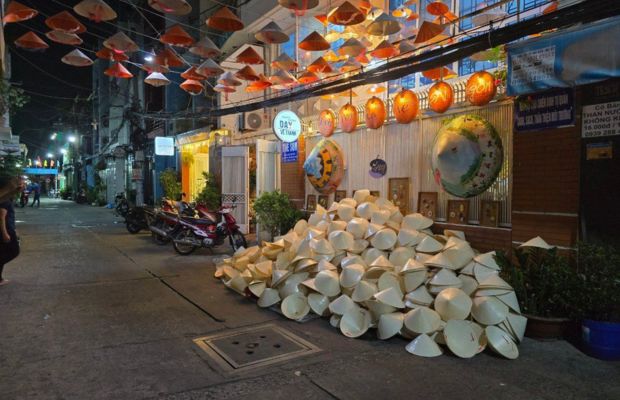
Phu Cam Conical Hat Village
Phu Cam Conical Hat Village is also on the list of outstanding traditional craft villages in Hue. This village demonstrates pure manual activities and the unique cultural and artistic features of the people in Hue. The village was founded in the 17th century when hat makers from neighboring regions came to this land to settle and develop the craft. Undergoing the history, Phu Cam conical hat craft village has become an indispensable part of the culture of the ancient capital Hue.
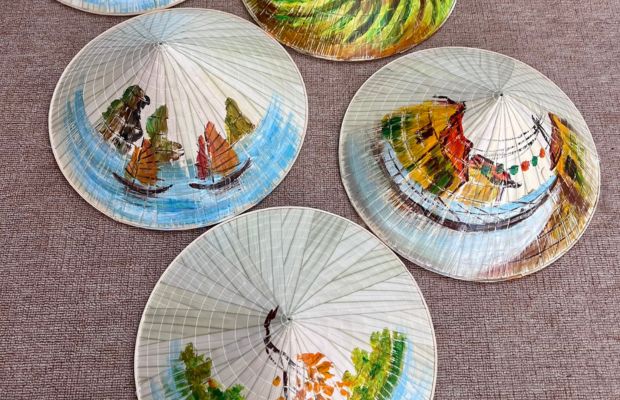
Phu Cam Conical Hat Village products
The village is well-known for its traditional types of conical hats. Each type has its own featured characteristics but still shows the skillful craftsmanship of the traditional hat makers here. Visiting the village, you can learn about the process of making a conical hat and creating your own conical hat products. The first step is to shave the bamboo, trim the rim, and build the frame to make it round and symmetrical. The beauty of the hat depends on the frame, so the artisans must maintain the technique of shaping the roof, the distance between the rims, and the roundness of the rim must be perfect.
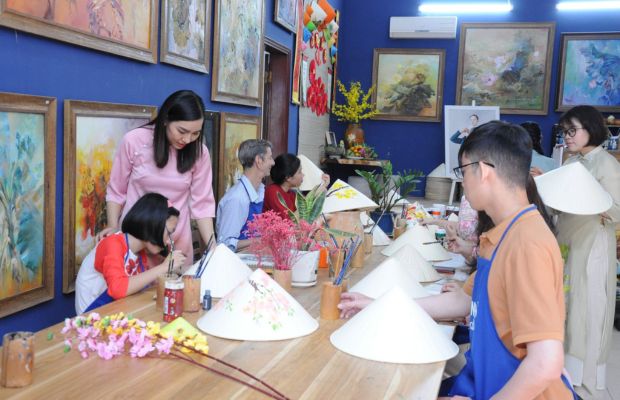
Decorating conical hats in Phu Cam Conical Hat Village
Local artisans also make the eaves of the hat carefully. They will choose the white and green leaves, and then carry out the incubation and drying steps. The artisans must ensure that the leaves still have a fresh, smooth green color and do not turn black or yellow after drying them. The final step in the hat-making process in Phu Cam Conical Hat Village in Hue is the step of sewing the hat. The artisans must be very skillful and delicate to carefully and meticulously sew transparent fishing lines on the leaves onto the hat brim.
Let’s visit the Phu Cam conical hat village, one of the featured traditional craft villages in Hue, and join the above exciting steps to make a conical hat!
Thanh Tien Bougainvillea Village
- Address: Phu Mau Commune, Phu Vang District, Hue
Among the traditional craft villages in Hue, Thanh Tien Bougainvillea Village is also an outstanding spot. The village has over 300 years of tradition in producing five-color paper flowers and paper lotus flowers. Coming here, you can find exquisite handmade paper flower products. Paper flowers are formed from folk beliefs. They are often displayed in important places of worship of the Hue people. They are Trang Ong, Trang Ba, Ong Tao, Am Mieu, etc. The village’s paper flowers make use of locally available, easy-to-find materials. What makes Thanh Tien paper flower village special is that people do not use industrial chemicals. They mainly use tree resins or leaves to make many types of dyes in a traditional way. Therefore, the color of the paper flowers lasts longer than other places.
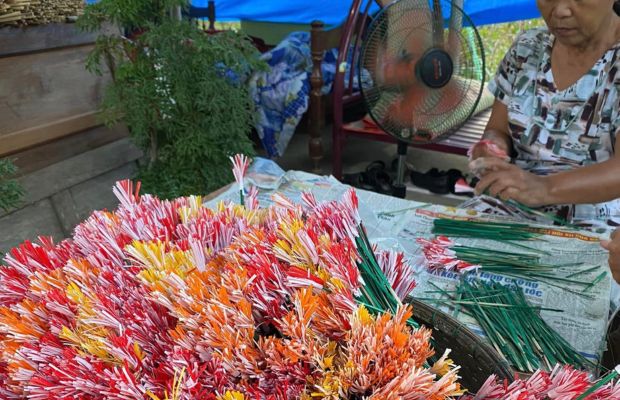
Making paper flowers in Thanh Tien Bougainvillea village
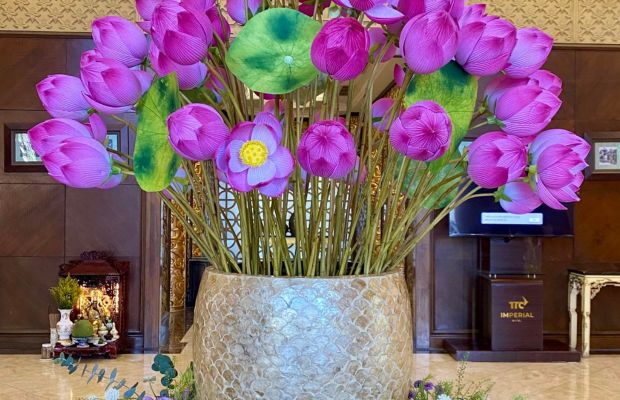
Lotus paper flowers in Thanh Tien Bougainvillea village
Visiting the village, you can admire the artisans with their meticulous hands bending bamboo, cutting and attaching each flower beautifully. The smell of bamboo, dye, and paper mixed with the bustling atmosphere here will definitely give you the most wonderful experience. You will have a chance to learn about the process of making paper flowers. Before making flowers, the craftsman must prepare the materials very carefully and it can take up to several months. The selection of bamboo is the most important factor. The bamboo needs to be flattened and dried. Colored paper is cut into flower shapes and glued. Each part is joined together and shaped to create the most beautiful flower.
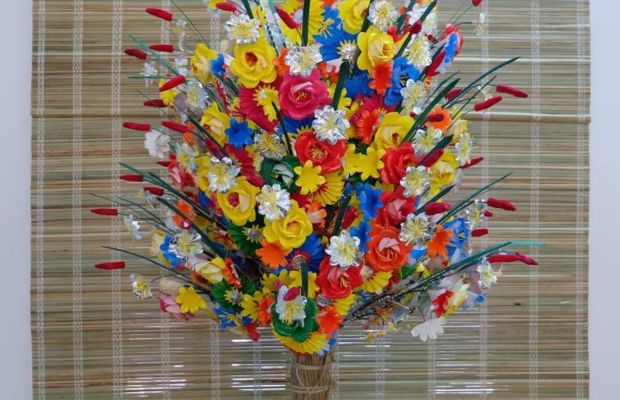
Colorful paper flowers in Thanh Tien Bougainvillea village
If you are looking for a colorful space, let’s visit Thanh Tien Bougainvillea Village, one of the worth-visiting traditional craft villages in Hue, and choose some paper flower products to bring home!
Phuoc Tich Ceramic Village
- Address: Phong Hoa Commune, Phong Dien District, Hue
Phuoc Tich Ceramic Village is also among the most ancient traditional craft villages in Hue, existing for more than 500 years. The village not only attracts tourists by the long-standing craft but also by the pristine beauty of rural life with peaceful, beautiful scenery, and cultural symbols such as banyan trees, ferry docks, and communal house yards. In the past, Phuoc Tich ceramic products were often offered as tribute to the Nguyen Dynasty to cook rice for the King. Currently, Phuoc Tich ceramic products are present everywhere in people's lives.
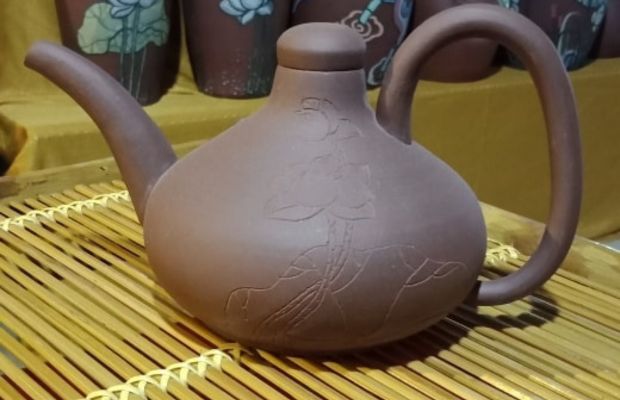
Ceramic products in Phuoc Tich Ceramic Village
The village’s ceramic products are made from clay and fired using traditional methods. The outstanding features of these ceramic products are not only their durability but also their uniqueness and variety of colors. Each ceramic product from Phuoc Tich village has its own unique beauty. They have a layer of glaze on the outside after the firing process, creating durability and a characteristic elegance. Besides, they have sophisticated patterns and diverse colors. Under the talented and creative hands of artisans, Phuoc Tich ceramic products have become symbols of creativity and the quintessence of national culture.
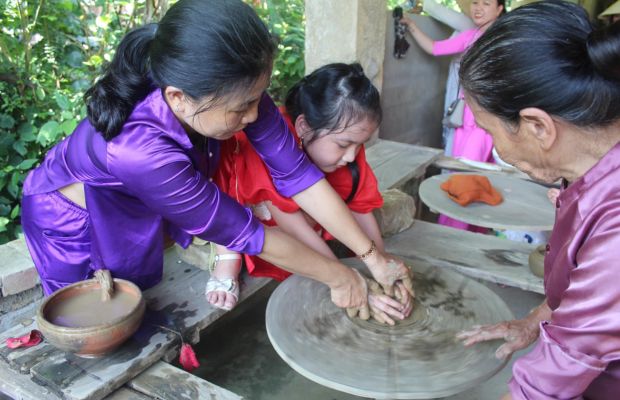
Besides seeing the ceramic products and learning about the ceramic-making process, you can also explore the ancient house system and visit the works with deep religious values when visiting the village.
Sinh Painting Village
- Address: Lai An Village, Phu Mau Commune, Hue
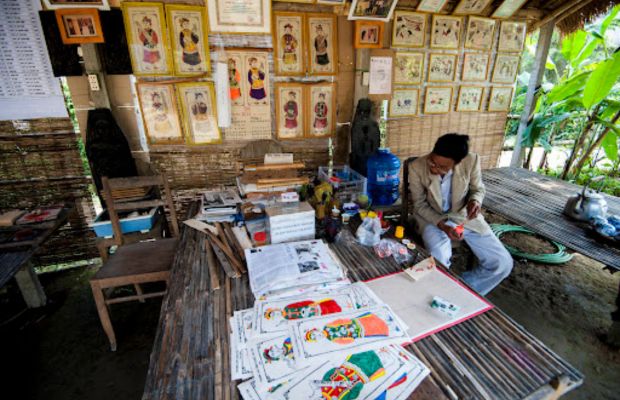
Sinh painting village
Sinh Painting Village, which has existed for more than 400 years, is also on the list the must-visit traditional craft villages in Hue. This is a traditional woodblock painting craft village for worship and serving the needs of beliefs, praying for peace, and warding off bad luck. Sinh paintings have about 50 themes, mainly reflecting social activities and ancient beliefs. Visiting the village, don’t miss out on the opportunity to experience these activities below.
Learning about the craft
Sinh paintings are printed on different sizes of Do paper. The woodblocks are made from jackfruit wood, thi wood, or zin wood to create the clearest lines. After printing, they will continue to be painted with colors prepared from leaves, ash, bricks, shells, etc. There are three main types of Sinh village paintings, including character paintings, object paintings, and animal paintings. The materials to make the paintings are mainly made entirely from nature, so the characteristics of Sinh village paintings are still handmade.
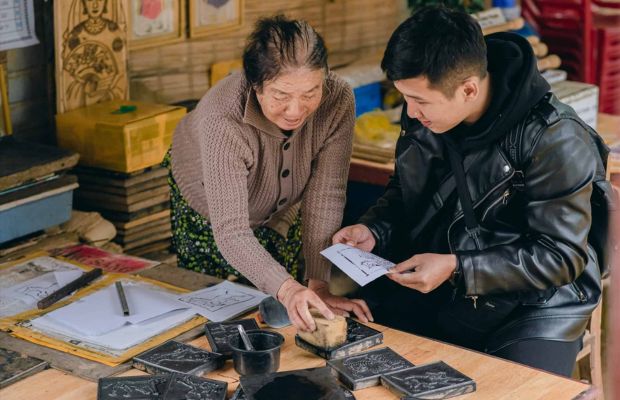
Learning to make paintings in the Sinh painting village
Making the painting on your own
Besides learning about the process, you can also try creating your own unique painting. You will use black ink to paint the woodblock, print it on Do paper and let the painting dry. After that, the artisans will guide you to use different colors to paint the painting. This activity contributes to the sustainable development of this traditional craft.
Bao La bamboo and rattan weaving village
- Address: Thuy Lap Village, Quang Loi Commune, Quang Dien District, Hue
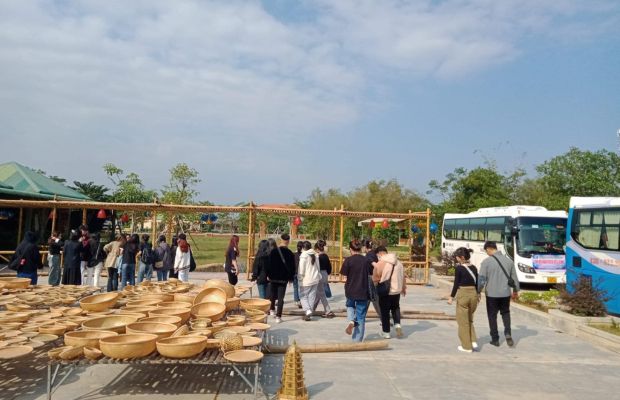
Visiting Bao La bamboo and rattan weaving village
Bao La bamboo and rattan weaving village is not only one of the featured traditional craft villages in Hue but also an attractive spot here. Coming here, you can experience making bamboo and rattan products. These products have become popular, thus creating a need for buying and selling on the market and specialization in production. Each hamlet in the village produces a different type of product. Cho Hamlet specializes in producing sieves and winnowing while Dong Hamlet specializes in producing baskets and trays. Whereas, Chua Hamlet specializes in producing trays, Dinh Hamlet and Hop Hamlet specialize in producing baskets, and Cau Hamlet specializes in producing trays and winnowing trays.
Ke Mon jewelry village
- Address: Dien Mon Commune, Phong Dien Ward, Hue, Thua Thien Hue
Ke Mon Jewelry Village is also among the featured traditional villages in Hue. Ke Mon jewelry is a craft that specializes in making jewelry from gold and silver using simple and complex decorative patterns. The products of artisans from Ke Mon jewelry village demonstrate a high level of aesthetics, imbued with Vietnamese cultural nuances. Talented artisans have crafted works of art following a strict process, with the essence of aesthetic value, creating a unique feature in each product. Besides admiring local artisans making jewelry products, you can buy these products to bring home when you visit the village. They can be jewelry necklaces, earrings, bracelets, bangles, rings, etc.
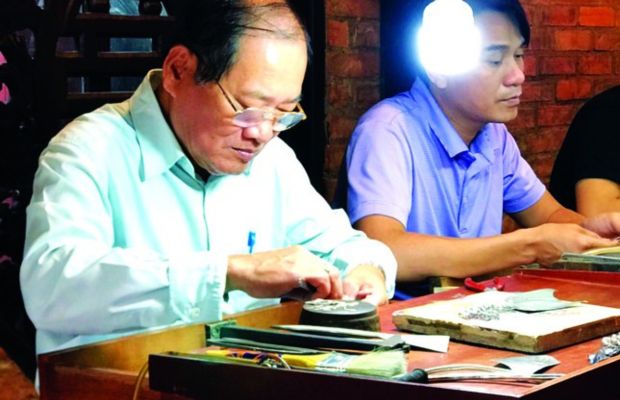
Local artisan in Ke Mon Jewelry Village
In conclusion, you have just learned about the most outstanding traditional craft villages in Hue. Hope just the above pieces of information will be helpful for you. If you want to book a Hue tour package or tailor your itinerary, please do not hesitate to contact our team.
__logo.png)
__hanoi-water-puppets.jpg)
__angkor-wat-blue-reflections.jpg)
__vientiane-buddha-park-monks.jpg)
__bagan-dhammayazika-dusk.jpg)
